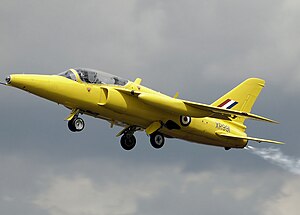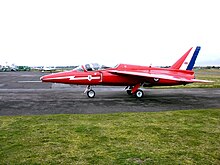Folland Gnat
| Folland Fo. 141 Gnat | |
|---|---|

|
|
| Type: | Fighter and training aircraft |
| Design country: | |
| Manufacturer: | |
| First flight: |
July 18, 1955 |
| Commissioning: |
1959 |
| Number of pieces: |
449 (including licensed structures at HAL ) |

The Folland Fo. 141 Gnat is a single-engine fighter and training aircraft produced by the British manufacturer Folland Aircraft Limited . She is known for her service with the Red Arrows aerobatic team of the Royal Air Force (RAF).
history
Under the leadership of WEW Petter , who had already designed fighter planes in World War II , the Gnat ( English mosquito ), a relatively small machine designed as a light interceptor , was developed at Folland in the 1950s on the basis of the Folland Midge . The Gnat was powered by a newly developed Orpheus jet engine with a thrust of 14.6 kN (1490 kp).
After the first flight on July 18, 1955 and the presentation in Farnborough on August 30, 1955, there with an engine that had been upgraded to 17.8 kN (1814 kp) of thrust, the British Air Force initially ordered 6 machines for flight testing. However, the Gnat did not meet all expectations during testing and lagged behind the competitor Hawker Hunter .
The fate of this machine would almost have been sealed if Folland had not received orders from foreign air forces. The Finnish Air Force acquired 13 and the Yugoslav Air Force 2 aircraft; In addition, the Indian Air Force IAF ordered 40 cells and a production license for the Gnat. In India, for example, 175 licensed aircraft were sold by Hindustan Aircraft Ltd. (HAL) , which also installed the cells supplied, and put them into service with the Air Force.
At HAL, the Gnat was further developed and used under the name “Ajeet” ( Hindi : the invincible, the unbeatable).
After the success abroad, the RAF decided to order the Gnat, but in a two-seater version as a trainer for the training of advanced jet pilots. The Gnat was supposed to replace the De Havilland DH100 Vampire , which was previously used for this purpose but was getting on in years .
After ordering a pilot series of 14 machines, which were called Folland Fo.144 Gnat Trainer - the first flight of this variant was on August 31, 1959 - Folland was faced with the situation of not receiving a follow-up order, as the company was not one of the the British government's preferred manufacturers. So it was decided to merge with the Hawker-Siddeley group. From 1960 production orders were placed for the aircraft, now known as the Hawker Siddeley Gnat T.Mk.1 . Some experts are of the opinion that Hawker Siddeley had recognized the potential of the Gnat, feared the competition of this aircraft and therefore bought the company Folland.
The deviations from the single-seater version were larger inner tanks, a different engine and enlarged wings to improve slow-flight characteristics.
In 1974 the Gnat's service in Finland ended, where the machines had proven themselves without modifications to the standard version at temperatures as low as −30 ° C; they have been replaced by Saab 35 Draken . In India, the Ajeet was developed in 1978 through a further development by Hindustan Aircraft Ltd. (HAL), which replaced Ajeet Mk. 2. The British Air Force used the Gnat until it was replaced by BAE Hawk machines in 1979.
The British aerobatic team Red Arrows , in which the Gnat T.1 had been the standard aircraft since the year this squadron was founded in 1965, also replaced it in 1980 by the BAE Hawk.
In the media
In the comedy Hot Shots! - The mother of all films , the US Navy flies the Folland Gnat, while the war opponents use the F-5 Tiger II . Both planes were considered obsolete in the year the film was made (1991), which underscored the film's comedic value.
Technical specifications
| Parameter | Data Hawker Siddeley Gnat T.Mk.1 |
|---|---|
| crew | 2 (pilot and student pilot) |
| length | 9.68 m |
| span | 7.32 m |
| height | 2.93 m |
| Wing area | 16.26 m² |
| Empty mass | 2331 kg |
| Max. Takeoff mass | 3915 kg |
| drive | a Bristol-Siddeley Orpheus 100 jet engine with a thrust of 19.0 kN (1919 kp) |
| Top speed | 1024 km / h at 9450 m altitude |
| Service ceiling | 14,630 m |
| Range | 1852 km (with 2 × 300 l additional tanks) |

